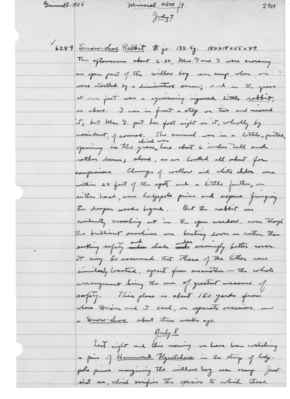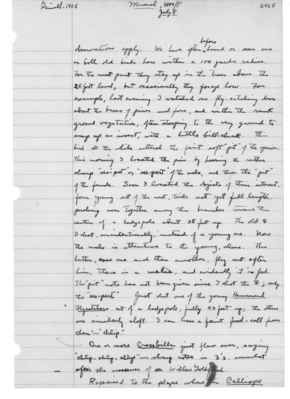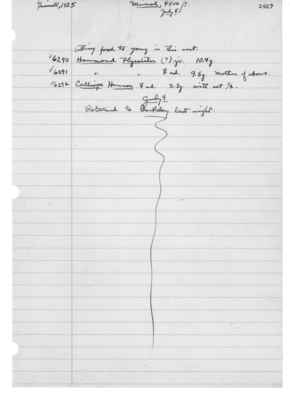Pages That Mention Hammond's Flycatcher
1925: Joseph Grinnell's field notes
S2 Page 67
Collector: Grinnell - 1925 Location: Mineral Date: July 5 Page Number: 2520
the most part, there [sic] are silent now. Tanagers, Hermit Thrushes and Warbling Vireos are still in song; but nearly all warblers, flycatchers and finches are quiet. Indeed, I heard the song of but one Hermit Warbler, where I heard dozens on June 22. Heard but 2 or 3 Audubon Warblers this morning. Heard a Grouse "boonting" in a big fir, so persistently that I circled the tree without disturbing him. I couldn't see him. Flushed a hen from the dusty trail, but failed to find any young.
6284 Hammond Flycatcher [female symbol] ad. 9.7g. Shot from fir twig about 30 ft. from ground in woods on ridge at 5500 ft. Note that molt has begun in innermost primaries, and that lower mandible is not especially dusky; indeed, it is quite pale flesh-color.
6285 Warbling Vireo [female symbol] 13.7 g. Contained fully formed yolk, a little "white" but not shell: would have laid 4th egg tomorrow. With nest and set 1/3 (incomplete, as above. ^Shot in willow. See p. 2519.
6286 Western Tanager [male symbol] ad. testes [testes illustration]. 28.6 g. Shot on ground beneath young firs, whither it had just; 5000 ft.
6287 Mariposa Fox Sparrow [female symbol] ad. 30.7g. Shot in thicket of arctostaphylos patula, in large tract of chaparral at about 5600 ft.
The young in the Wright Flycatcher's nest at camp, which hatched on June 17 (see p. 2491), left the nest voluntarily this forenoon sometime. Time in nest, 18 days ±.
6288 Bufo boreas found under board in our tent.
S2 Page 71
Collector: Grinnell - 1925 Location: Mineral, 4800 ft. Date: July 7 Page Number: 2524
6289 Snow-shoe rabbit [male symbol] ju. 132.5 g. 180x18x55x49.
This afternoon about 2:30, Mrs. G and I were crossing an open part of the willow bog near camp, when we were startled by a diminutive stream; and in the grass at our feet was a squirming injured little rabbit, as above. I was in front a step or two and missed it; but Mrs. G. put her foot right on it, wholly by accident, of course The animal was in a little, parted opening in the grass ^which was here about 6 inches tall and rather dense; alone, as we looked all about for companions. Clumps of willow and white alder were within 25 feet of the spot; and a little farther, on either hand (?), were lodgepole pines and aspens fringing the deeper woods beyond. But the rabbit was evidently crouching out in the open meadow, even though the brilliant sunshine was beating down - rather than seeking safety underand shade andunder seemingly better cover. It may be assumed that others of the litter were similarly located, apart from one another - the whole arrangement being the one of greatest measure of safety. This place is about 150 yards from where Dixon and I each, on separate occasions, saw a Snow-shoe about three weeks ago.
July 8 Last night and this morning we have been watching a pair of Hammond Flycatchers in the strips of lodge pole pines margining the willow bog near camp. Just shot one, which verifies the species to which these
S2 Page 72
Collector: Grinnell - 1925 Location: Mineral, 4800 ft. Date: July 8 Page Number: 2525
observation apply. We have often ^before head or seen one or both old birds here within a 100 yards radius. For the most part they stay up in the trees above the 25-foot level, but occasionally they forage. For example, last evening I watched one fly-catching down about the bases of pines and firs, and within the rank ground vegetation, often stooping to the very ground to snap up an insect, with a little bill-click. This bird all the while uttered the faint soft "pit" of the species. this morning I located the pair by hearing the rather sharp "see-put" or "see-pert" of the male, and then the "pit" of the female. Soon I located the objects of their interest, four young out of the nest, tails not yet full length, perching near together among the branches toward the center of a lodgepole about 25 feet up. The old [female symbol] I shot, unintentionally, instead of a young one. The latter, now one and then the other, fly out after him, there is a melee, and evidently it is fed. The "pit" note has not been given since I shot the [female symbol], only the "see-pert." Just shot one of the young Hammond Flycatchers out of a lodgepole, fully 40 feet up; the others are similarly aloft. I can heard a faint food-call from them - "chlip."
One or more Crossbills just flew over, saying "chup - chup - chup" - sharp notes in 3's, somewhat after the manner of a Willow Goldfinch.
Repaired to the place where the Calliope
S2 Page 74
Collector: Grinnell - 1925 Location: Mineral, 4800 ft. Date: July 8 Page Number: 2527
Taking food to young in this nest.
6290 Hammond Flycatcher (?) ju. 10.4g. 6291 [Hammond] [Flycatcher] [female symbol] ad. 9.5g. Mother of above. 6292 Calliope Hummer [female symbol] ad. 2.3g. with set 1/2.
S2 Page 81
Collector: Grinnell - 1925 Location: Broke-off Mt. Date: July 27 Page Number: 2533
foliage which the breeze kept in disconcerting agitation); Cassin Purple Finch (2 or more, distantly heard and seen in tops of hemlocks); Sierra Grouse (2, as above); Hammond Flycatcher (2 immatures, separately, seen closely in hemlocks at 8000 to 9000 ft.); Junco (2, in hemlocks).*
In the red-fir belt (Canadian), 8000 ft., about, down to 7000 ft., where we left the machine, noted: Deer (doe and fawn at edge of alder thicket); Callospermophilus (2 or more); Thomomys monticola (sign common); Fox Sparrow (one immature near patch of heather along little stream at 8000 ft., and others heard in alder patches); Juncos (commonest bird, one [male symbol] singing at tip of lofty red fir - many full-grown young in scattering troupes); Evening Grosbeak (one family of 5 or so alighted on dead lower branches of a fir and notes of others were heard now and then); Solitaire (one flushed from ground); Siskin (notes of 2 or 3 heard overhead); Blue-fronted Jay (heard several times); Cassin Vireo (2 immatures closely seen in a jungle of white alders); Hammond Flycatcher (weak call notes heard often, and one bird seen, 30 feet or so up in densely shaded branchwork of fir); Wood Pewee (pair at 7000 ft.); Pileated Warbler (song of one heard from alders); Robin (a pair at a little ^moraine lake in the fir woods was noisily concerned at our presence); Audubon Warbler (a family, male singing, in trees at this same lake); Canada Nuthatch (notes heard in the distance).




